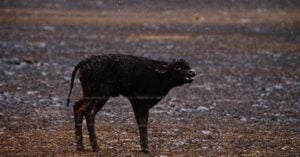Firefighters continued to battle strong winds across the Texas Panhandle while attempting to contain the Smokehouse Creek Fire, which has become largest wildfire in Texas history and the second largest in U.S. history.
State officials reported on Saturday that at least two people have died, while 500 structures were destroyed in the blaze. The blaze has now spread to Oklahoma.
Texas Agriculture Commissioner Sid Miller asked for hay and feed donations and prayers for residents who have lost homes and livestock in the “monster” fire, saying he expects the death toll for livestock to soar. Miller reports that over 3,000 head of cattle have died, and more will be euthanized in the days and weeks to come.
“Cattle and crop losses in the Panhandle are significant, and infrastructure damage is catastrophic. Even those Texans fortunate enough to save their herd may not have anything to return to, but ashes,” Miller wrote. “The path forward as an agricultural operation is unclear without home and belongings. Hemphill County has reported over a thousand missing or dead cattle and several dead horses, goats, and sheep. Numbers in Hemphill County and other impacted areas are expected to rise as the smoldering fire subsides, and assessment can be conducted.”

While light rains on Feb. 29 helped restrain the fire, as of Sunday, the Smokehouse Creek Fire was only 15 percent contained. It has burned over 1.1 million acres (1,700 square miles) across the Panhandle, spreading into Oklahoma, where tens of thousands of acres have already burned.
Red flag warnings were issued by the National Weather Service throughout the day on Sunday as humidity dropped below 15 percent and wind gusts reached over 50 miles per hour in portions of the state.
According to news sources, two other fires burning in Texas were 60 percent contained as of Sunday. Authorities have still not said what ignited the fires, but winds, dry grass, and warm temperatures have fueled the flames.
Cooler temperatures Monday and fewer strong winds have been predicted to last through Tuesday — weather that firefighters hope will help them to gain better control of the blaze.
Surrounding communities have stepped up to donate hay and feed resources, to support emergency responder needs, and have provided transportation to haul livestock and hay as needed.
The state has temporarily suspended oversize/overweight permitting requirements for vehicles and loads associated with activities necessary to respond to the disaster and has set up livestock supply points. Additionally, the Texas Animal Health Commission has facilitated a waiver of animal movement documentation for livestock producers because of the 2024 Texas Panhandle wildfire.
Red flag warnings were also issued this weekend for extensive areas in Nebraska, where another fire has burned over 70,000 acres, and Iowa, as well as significant parts of Kansas, Missouri, and South Dakota. Portions of Colorado, Wyoming, Minnesota, and Illinois were also placed under red flag warnings.


